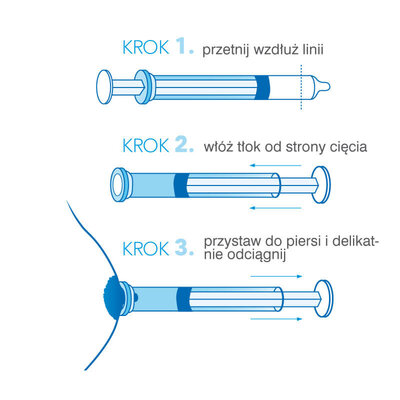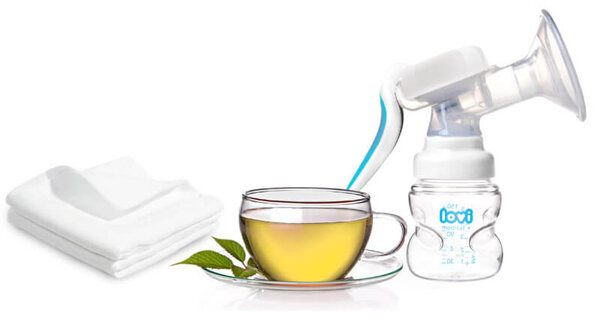The beginning of breastfeeding may be difficult. The breastfeeding skill must be mastered by both mother and child. Mistakes made during breastfeeding and the lactation physiology may bring about temporary problems. Learn more about their causes and ways of solving them.
Initial breastfeeding problems are usually caused by incorrect latching on.
Too shallow latch on the areola and nipple biting result in sore nipples, poor emptying and consequently milk stasis which might lead to breast inflammation. To avoid this, work on your latching on technique.
To avoid this, work on your latching on technique. However, not all problems can be avoided, as the breastfeeding skill must be mastered by both mother and child.
Too shallow latch on the areola and nipple biting result in sore nipples, poor emptying and consequently milk stasis which might lead to breast inflammation. To avoid this, work on your latching on technique. However, not all problems can be avoided, as the breastfeeding skill must be mastered by both mother and child. The following tips will help you deal with possible problems.
Sore nipples may be initially related to hormonal changes and increased susceptibility to irritation. Breasts must get used to suckling, and pain should subside after a few days. You can also feel pain if your child does not cover the whole areola with his mouth, but only a small portion of it, and he bites and hurts the nipple with gums.
The reasons for painful and sore nipples may be as follows:
Poor latching on technique or incorrect feeding position
Incorrect latch on a hard and filled breast during high milk supply
Shortened lingual frenulum
Difficulty with latching on an inverted nipple
Pressing the breast with a finger during suckling makes the nipple move inside the baby's mouth
Incorrect way of removing the nipple from baby's mouth after feeding
Greedy and hard latching on the nipple by a hungry child
Milk let down reflex disorders
What can you do?
After attaching the child to the breast make sure he properly latched on the nipple, and that most of the areola is inside his mouth. His lips should be wide open and curled out like in a fish.
Take short breaks between feeding.
If you feel the breast is hard and difficult to latch on, express some milk before feeding with your hand or a breast pump.
To stimulate the let down reflex before feeding shower the breasts with warm water and express some milk.
Wash your breasts with water no more than twice a day. Do not use soap as it dries and irritates the nipple.
Air sore nipples. Wear loose, cotton and airy blouses at home, and put on a bra and breast pads before going out.
If your clothing hurts, you can put small handle-less strainers bought in a tea shop or protective shells into your bra between feedings. They ensure air access, and prevent the nipple contact with a material.
Between feedings use sage or calendula infusion to soak the sore nipples.
Rub the nipples with your own milk after feeding.
Between feedings use a healing ointment that needs not to be washed off. Before feeding make sure the ointment does not remain on the skin - slippery areola can make the child's lips slip and latch on will be incorrect.
Remove the nipple from baby's mouth by inserting a finger between the breast and a corner of his mouth. This way you can break the vacuum, and the suckling stops.
If the nipples are so cracked that pain prevents the breastfeeding, feed the baby using accessories that do not disturb the suckling reflex until the nipples are healed.
Flat or inverted nipples may initially hinder breastfeeding, but they are not a reason to abandon it. Proper latching on technique is half the battle in overcoming this problem.
What can you do?
 Feed as often as possible. Frequent suckling is the best nipple shaping exercise.
Feed as often as possible. Frequent suckling is the best nipple shaping exercise.
Express some milk with a breast pump before feeding to facilitate effective latch on the areola.
Shape your nipple with fingers between feedings. Hold the nipple between thumb and forefinger and rub it to and fro, and pull gently. You can also use a syringe to pull away the nipple, previously cutting the syringe needle tip and inverting the plunger.
Express milk with a breast pump after and between feedings - it is also an excellent exercise for nipples.
If, despite your attempts, the baby does not want to suckle, consult a lactation specialist or a speech therapist.
You have noticed that your breasts have become heavy, swollen and you feel uncomfortable. Keep calm and read what to do in the case of milk stasis or breast fullness. The tips below are very important and will help you to prevent breast inflammation.
The first breast fullness, i.e. high milk supply, occurs between 3 and 5 day after birth. Later on it can occur after a longer than usual break between feedings, or when the baby does not empty the breast well enough. Breasts become hard, tense, sometimes hot, and milk flows easily.
Starting increased milk production
Expressing large quantities of milk with a breast pump that overstimulates milk production
Longer than usual break between feedings
Child does not empty the breast well enough (incorrect latch on, biting the breast instead of suckling, e.g. during teething)
What can you do?

To stimulate the milk flow shower the breast with warm water or put a warm diaper compress.
Express some milk with a breast pump before feeding to help your child latch on. Do not express large amounts of milk because it stimulates lactation even more.
You can drink sage infusion to reduce milk production.
Use a cold compress after feeding (e.g. chilled diaper).
The symptoms are similar to breast fullness. Breasts are hard, full and warm, and in some cases redness may occur. Milk accumulated in alveoli does not flow when it is expressed with a breast pump. You may feel small bumps under the skin - it means that a milk duct has been blocked.
Incorrect feeding technique or position
Long interval between feedings
Incorrect technique of expressing milk manually (painful chest compressions)
Stopping the night feedings (feeding the baby with infant formula)
Wearing a too tight bra pressing the breasts and blocking milk flow
Fatigue, pain, stress, illness disrupting oxytocin production, and disrupting the let down reflex
What can you do?
Make sure your bra does not compress the breasts. You can even give it up for some time.
Encourage your child to suckle as often and as long as possible.
Drink plenty of fluids.
Take a warm shower before feeding - it will facilitate the let down.
Change feeding positions so that the child empties the whole changed breast.
A large amount of liquids and sprout wraps may be helpful

Latch the baby on more often to the breast with stasis.
After feeding put chilled cabbage leaves on the breasts (peel a leaf, wash it, crush it a bit with a pestle and slid inside your bra). They have painkilling and anti-inflammatory properties.
Do not use strong massage of the breast and do not express large quantities of milk with a breast pump..
You can gently stroke the breast towards the nipple.
Avoid manual milk expression.
Avoid stress and try to relax so as not to inhibit the let down reflex.
Mastitis is characterized by weakness, high fever, muscle pain. Breasts are hot and hurt. Improper conduct during milk stasis is a common cause of mastitis: reducing drinking liquids, stopping breastfeeding with the sick breast, strong and painful breast compression.
What can you do?

Breastfeed from the sick breast often and long, every 1.5 - 2 hours.
Use different feeding positions, especially the clutch hold.
Use anti-inflammatory cabbage compresses.
Take a painkiller with ibuprofen or paracetamol.
Contact a doctor if there is no improvement after 1 day. He will probably prescribe an antibiotic, which is harmless for your baby and allow you to continue breastfeeding.
Many mums worry whether their breasts produce enough milk. The doubts usually occur when a child often cries, demands breast more frequently than usual, breasts become soft and you do not need breast pads anymore. However, these factors do not indicate low milk supply.
Crying does not necessarily mean that your child needs more food - if he gains weight properly, there is another reason for crying. Increased milk demand occurs during developmental leaps - about 3, 6 and 12 week and 3 and 6 month of age. Then the baby may want to suckle all the time, and thanks to it milk production increases within 2-3 days in accordance with growing needs of the little one. Actual low milk supply can be suspected if baby's weight gain is insufficient, if he uses less than 6 diapers a day in the first month of life, and when he is constantly anxious. If this is the case you should consult a lactation specialist who will be able to determine the cause of inadequate milk supply and recommend appropriate action.
Lactation has not been properly activated during early breastfeeding due to mother's or child's health problems
Let down reflex was disturbed by stress, fatigue, pain, emotional problems
Reduced fluid and food supply, anemia
Long intervals between feedings - too rare and weak stimulation of milk production
Feeding a baby with formula without consulting your doctor - it reduces the number of breastfeeding sessions and limits lactation
What can you do?
Feed frequently. Do not give up night feedings.
Ask your family for help with daily chores. Try to rest a lot, especially in the first month after birth.
Lactation tea, electronic breast pump Prolactis and water may be helpful

Express milk with an electric breast pump between feedings. Effective e xpressing of large amounts of milk will increase its production.
xpressing of large amounts of milk will increase its production.
Make sure to drink 2 liters of fluid a day and keep a healthy diet (frequent meals rich in vitamins, protein, calcium and other nutrients).
Drink nursing tea for breastfeeding women.
You can stimulate lactation by frequently expressing milk between feedings.
There are situations that the child does not want to suckle during early breastfeeding or later on. Find out what the cause may be and how you can remedy this problem.
Poor or distorted suckling reflex (as a result of premature birth, injury, illness or immaturity of the nervous system)
Problems related to baby's oral cavity anatomy
Excessive agitation, restlessness, anxiety in the baby
Nervousness, tension experienced by mum and felt by the baby
Runny and stuffy nose of the baby
Teething, sore gums
Thrush in the baby's mouth
Flat or inverted nipples
Reluctance to changes in mums' body odour (perfume, deodorant, soap)
Different taste of milk after eating e.g. garlic, onions
What can you do?
If your child does not want to suckle in the first days after birth, you should immediately consult a lactation specialist or a speech therapist. He will thoroughly examine the baby's mouth and check the suckling reflex. He will also recommend appropriate exercises.
Try to relax and unwind before feeding.
Breastfeed in a shaded room and in silence - lack of excessive stimuli should soothe the baby's anxiety.
Try different positions and see which is the best for your child.
Check your child's mouth for thrush or injury. If you find any, contact your doctor in order to treat them.
If your child has a runny or stuffy nose, use saline and remove excessive secretion with an aspirator. In winter, use a humidifier in the room where the baby sleeps.
When the baby is teething, use an analgesic gum gel before feeding. Older child can be given ibuprofen syrup.
If your child continues to deny the breast, try to feed him in this period using the accessories that do not disturb the suckling reflex. Older child can be spoon-fed with cereal based on your expressed milk.
Use unscented soaps and gels and delicately scented deodorants.
Give up food products that can change the taste of your milk.
Are you pregnant and intend to breastfeed? Or maybe you have already given birth and are looking for information here because of problems with breastfeeding your baby? Sometimes, something that seems natural is not easy, ...
Can I breastfeed after a C-section? Will I have milk? Will my baby know how to suck?" These questions often trouble future mothers with an elective C-section. We would like to convince you that a C-section is not an obstacle ...
Many mums worry whether their breasts produce enough milk. The doubts usually occur when a child often cries, demands breast more frequently than usual, breasts become soft and you do not need breast pads anymore. However, ...
To achieve successful beginnings of breastfeeding, you will need self-confidence, patience, support from the loved ones and getting acquainted with a handful of tips that will allay fears and doubts.
Although many mums worry about it, breastfeeding does not make breasts unattractive. Just take care of them properly choosing the appropriate underwear, cosmetics and products for lactation hygiene.
The initial failure of breastfeeding may be associated with sore, inverted or flat nipples. Explore solutions to help yourself overcome these problems.
During feeding the baby sometimes swallows air that accumulates in the digestive tract and can cause colic, bloating and posseting. Therefore, after each feeding you should encourage your child to burp. We show 3 burping ...
What is the difference between colostrum and the proper milk? How to latch? We ask ourselves these questions at the beginning of feeding. Here you will find the answers.
Breastfeeding is a wonderful gift that nature gave to women. A gift both for the child and for mothers themselves. Explore the benefits of breastfeeding.
A popular opinion says that breastfeeding is a great sacrifice on a woman's part for a baby's good. The truth is this way of feeding is advantageous not only to the baby but also to the breastfeeding mum.
